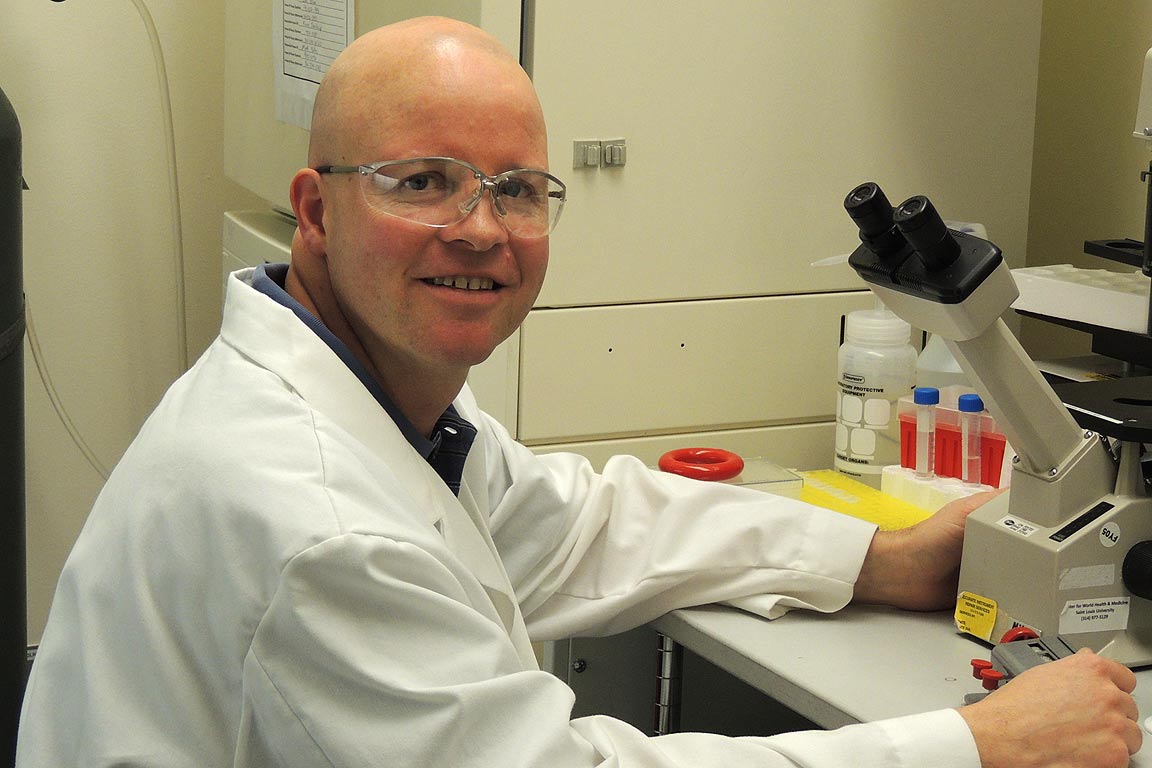A Father’s Love Steels Scientific Quest
Fran Sverdrup, Ph.D., a researcher at SLU’s Center for World Health and Medicine, is playing beat the clock in finding a treatment for a rare form of muscular dystrophy.
Raw determination to keep his 15-year-old daughter out of a wheelchair fuels his research that, hopefully, will change the future for his child and others who have the rare disease.
His daughter was diagnosed with fascioscapulohumeral muscular dystrophy (FSHD) in 2011. The disease typically starts with muscle weakness in the face and spreads through the body -- stripping muscles in the shoulders, upper arms and legs of their strength.
“I’m going to figure this out,” Sverdrup said, in sharing with St. Louis Magazine his personal story that chronicled how he lost his heart to his smart, beautiful and impish daughter who has a health problem he is desperate to fix.
“My goal all along was the fairytale ending. There’s no other goal. But with drug discovery, you have to be realistic. The best-case scenario is a clinical trial in two or three years,” Sverdrup told St. Louis Magazine, as he blended hope with resolution.
“I can’t get her into that, because it won’t be pediatric. But by the time she’s an adult, there will be something nearing the market, so when she’s in her twenties and can still be helped, it will be available.”
Right Place, Right Time
In 2010, Sverdrup was among a group of Pfizer scientists who joined SLU to create a research center that builds from the University’s Jesuit values. The Center for World Health and Medicine studies promising drug compounds to find treatments and cures for rare illnesses and diseases of poverty that are debilitating, life-threatening and typically ignored by pharmaceutical companies. Because its scientists have expertise in translational research that is uncommon in an academic setting, they can speed up the process of bringing a drug candidate from research bench to patient’s bedside.
"When my daughter was diagnosed with FSHD, I realized I had the opportunity to jump in and do something about it. The very mission of the center allowed me to start a new research project, a project aimed at finding a therapy for my own daughter," Sverdrup said.
Pete Ruminski, executive director of the center, remembers the day Sverdrup asked to spend time working on a therapy for FSHD. Silly question.
“This is the kind of thing they make movies out of. Daughter gets diagnosed, father has the skills to actually do something about it and he fortuitously joined a center that actually focuses on these kind of diseases,” he said in a video about Sverdrup’s quest for a FSHD treatment.
Discovering a treatment for FSHD became a goal embraced by fellow scientists at the center, Ruminski said.
“When it becomes personal like that and we know that we have the skills to do something about it, that just gives that extra motivation, that extra passion.”
Sverdrup’s Search
Sverdrup is uniquely positioned to study his daughter’s disease in other ways. He has studied epigenetics and researches drugs that trigger the immune system to regulate certain genes.
Within a year of his daughter’s diagnosis, Sverdrup discovered a compound that turns off the gene that is abnormally expressed in FSHD cells, possibly correcting the defect. He sought a patent on the discovery, helped launch the Dance N Donate campaign and began looking for a pharmaceutical partner that could turn his findings into a potential treatment for FSHD.
He found that partner in Ultragenyx Pharmaceuticals, a biopharmaceutical company that develops novel products for rare and ultra-rare diseases. In March 2016, SLU announced a three-year collaboration with Ultragenyx, to advance Sverdrup’s discovery.
The company will fund the next step in Sverdrup’s research, turning the compound into an actual drug. If it works in initial proof of concept testing, the drug candidate will be evaluated in human clinical trials to assess its safety and efficacy, according to Muscular Dystrophy News Today.
"Everything is full speed ahead right now. I'm thrilled that we have a committed partner who is intent on driving this forward as quickly as possible, to get this into the clinic," Sverdrup said.
"Our goal is to develop the first therapy for all patients with this disease, including my daughter. This is an important step in a long, often difficult process, certainly a great milestone in our efforts to bring a therapy forward."
The father’s goal is in sight, and the team at the Center for World Health and Medicine is ready to push him across the finish line.


















